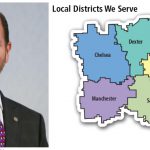Virtually every major media outlet has given their take on the 2016 Presidential election, to the point where these examinations feel more indicative of each outlet’s identity than any real, comprehensive explanation of the event. Statistics-driven 538’s series focuses on how the rest of the media misinterpreted the polling data, perennial news explainer Vox largely covered the mentality of a confused electorate, Time’s immediate post-mortem reflected the magazine’s bias toward conventional media wisdom, etc. For media organizations, the 2016 election is a grand and complicated Rorschach test: what you see in the pattern is about you, not the pattern.
With this three part series looking back at the election, Torchlight hopes to cut through the distorted, ideology-driven conversation by laying out the facts to draw clear and comprehensive conclusions about the nature and causes of the event.
On Monday, Tom Rich talked about the Republican primary resulting in the nomination of Donald Trump. On Wednesday, I discussed the Democratic primary resulting in the nomination of Hillary Clinton, and today the series concludes with Andrew Coleman’s examination of the many significant factors that led Trump to victory and the Presidency over Clinton. We hope you find the series enlightening and clarifying.
– Josh Kyu Saiewitz
I. What Actually Happened?
Democrats are still reeling after their defeat in the 2016 presidential election. Many of us feel like the loss to Donald Trump means that we do not understand our country and that is a far more jarring realization than the political defeat in and of itself. How did we lose to that guy? My goal with this piece is to look at all the factors that led to Trump’s victory in November and what Democrats can do going forward to win elections.
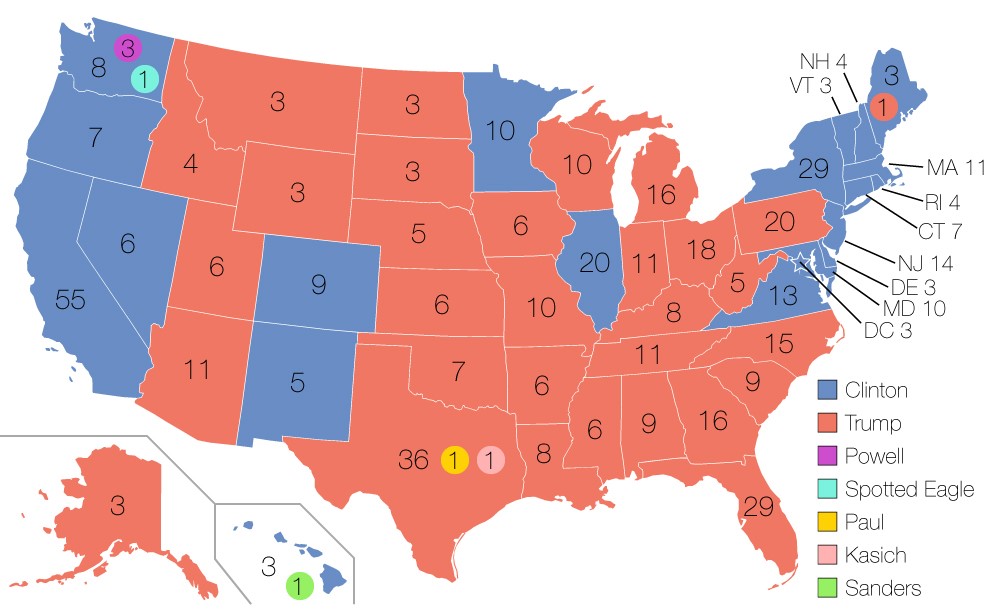
To start we need to take a look at what happened specifically. Trump won the electoral college, 304 votes to 227 with 7 faithless electors voting for Colin Powell (3), John Kasich, Ron Paul, Bernie Sanders, and Faith Spotted Eagle. He did this powered by narrow victories in industrial Midwestern states: Pennsylvania, Michigan, and Wisconsin. He won those three states by a total of around 80,000 votes. Meanwhile the popular vote was a slim but decisive Clinton win of 2.1%: 65,853,516 to 62,984,825 with about 7 million third party votes, the majority of which went to the Libertarian Gary Johnson (4,489,221), Green nominee Jill Stein (1,457,216), and independent Republican protest vote Evan McMullin (731,788). At the same time, Republicans won the Congressional popular vote nationwide by 1.1%, 63,173,815 to 61,776,554 with about three million third party votes, mostly going to the Libertarians, independents, and the Greens.
The major conclusion I take from those numbers is that any argument that looks at Hillary Clinton’s loss should also examine why Congressional Democrats underperformed her.
II. The Fundamentals
Political scientists will tell you that the major factor in any campaign for the presidency is not campaigns, or even the candidates really, but what they call the “fundamentals.” Nate Silver has a good run down of this element in his attempt to tackle the same issue of how Clinton lost. The fundamentals are the political climate entering the election which usually focus on three factors: the economy’s performance, military casualties, and incumbency. The definition of the first varies by model, sometimes it just looks at GDP growth, other models use the change in GDP in the year before the election. I’ll give a couple examples: In the former if the GDP is growing at 1.5% in the year of the election, that’s not great for the incumbent party. However, if the year before the economy had been in a recession, the latter model would note the significant positive change in GDP and say that was good for the incumbent. Other models use the unemployment rate as a proxy for the same idea. I think the second model is better, because it helps us explain how Barack Obama could win re-election fairly easily despite a relatively weak economy. It was getting better, so voters stuck with him.
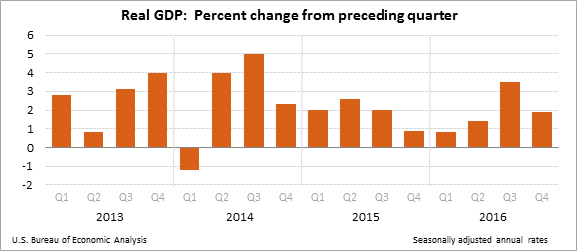
Going into the election, things were relatively weak and importantly not going as well as they had been in the spring and summer of 2015, as we can see in this chart from the Bureau of Economic Analysis. That creates a bad atmosphere for the incumbent party. The third quarter boost and the associated gains in real income might have helped, but by the summer partisan inclinations were starting to harden.
The second element, military casualties, is straightforward. The more of these there are, the worse it is for the incumbent party. This crippled Lyndon Johnson in 1968, for example. For this election, the Military Times lists 24 deaths in 2016 in Afghanistan. Most other American operations were theoretically non-combat adviser roles or air campaigns, which are low American casualty affairs. This was a non-factor, and with the exception of the IAVA forum this issue and those related did not receive a lot of attention.
The third factor, and probably the most important one, was that Americans tend to not stick with the same party in the White House for a long time, especially post-WW2. Since the end of the war only Truman in 1948 and George HW Bush in 1988 have won a third or more consecutive term for their party. Democrats lost in 1952, 1968, 2000, and 2016, while Republicans lost in 1960, 1976, 1992, and 2008. Clinton was working against this headwind and when combined with the mediocre economy, a generic Democrat was probably a slight underdog to a generic Republican. Of course, we got neither in this election.
III. Racism
In his piece looking at the Republican primary, Tom explained how a key predictor of Trump preference in the primary was racial attitudes. The more likely a voter was to express skepticism or hostility towards diversity, the more likely they were to prefer Trump over his Republican rivals. What has been less well documented is that the same pattern held with swing voters who switched from Obama to Trump. Hostility to diversity was a strong predictor of voter defection from Obama to Trump, which were approximately 9% of voters. Meanwhile, the swing voters who switched from Romney to Clinton were more likely to be comfortable with diversity. This indicates that hostility to diversity was a key factor in the crucial Obama to Trump voter decisions.
Does this mean those voters are unwinnable for Democrats? It’s hard to say. Both campaigns treated race differently than the campaigns of Obama and Romney. Trump was far more hostile towards minority groups, whether it was his extreme line on Mexican immigration, questioning Judge Curiel’s ability to impartially adjudicate a Trump University case, the advocacy of birtherism that launched his political career, or his description of African-American neighborhoods in our cities as being dangerous where merely walking down the street was likely to make one the target of gunfire. Republican campaigns have long used so called dogwhistle politics, best explained by this Lee Atwater quote (warning: racial epithets) about the Southern Strategy. Trump went back to saying the quiet parts loud, which was different.
Meanwhile, Obama often relied on his status as a black man to convey messages about racial equality during his campaigns. The brushing of his shoulders or singing a few lines of Al Green. He was a master of code switching. He rarely, with the exception of his “A More Perfect Union” speech in response to the Rev. Wright controversy, explicitly dealt with race in his campaigns. And that speech was all about unifying his identity as a black man with his identity as the son of a white woman, and particularly white grandparents from Kansas. People read into that an ability to unify and heal the country’s long, sordid history with race. An ability he discounted in that very speech. What I’m saying is that Barack Obama was an exceptionally skilled politician, not that this is news.
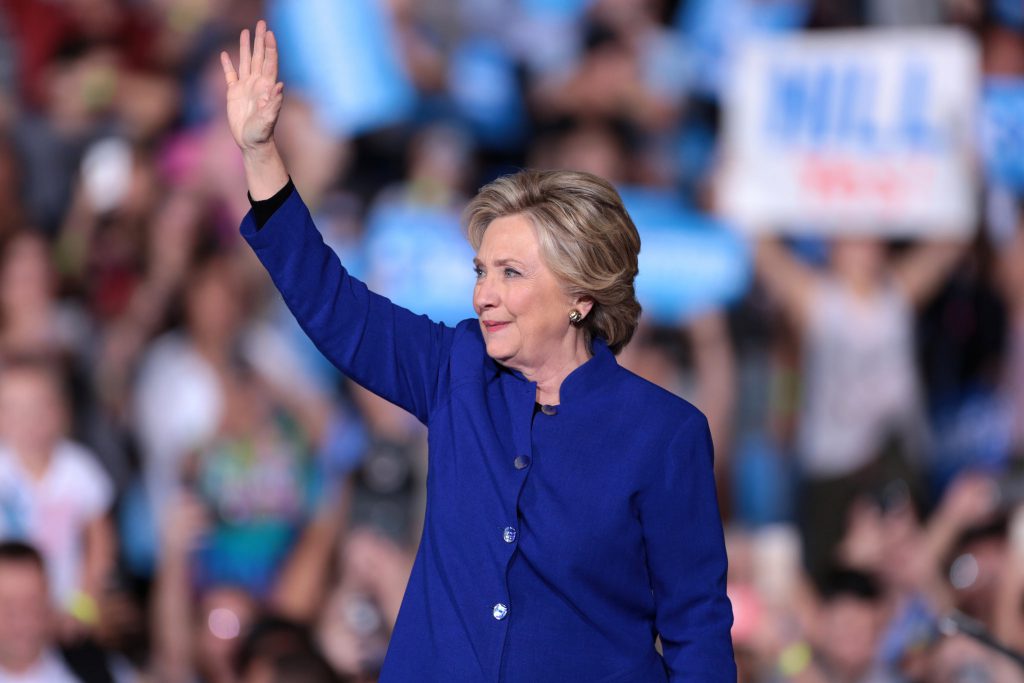
Hillary Clinton, on the other hand, is a gifted public servant, but not a brilliant politician. She had the support of the African-American community, but could not count on turnout the same way that Barack Obama could because of the historic nature of his candidacy. Black turnout in Detroit, Milwaukee, Cleveland, Columbus, Chicago, and Philadelphia is a huge factor in if Democrats can win elections in those states so she needed those turnout numbers. The Obamas as prominent surrogates helped, but she decided out of political necessity and I suspect moral imperative to highlight cases of racial injustice during the campaign in a way Democrats had not since the 1960s. The “Mothers of the Movement,” women whose children had been killed by police or vigilante shootings, got a prominent speaking slot at the convention and Clinton frequently used the term “systemic racism” asking all Americans to examine the way that society, rather than individual racist actions, were harming minorities. It is possible that by addressing these concerns directly Clinton activated racist sentiments in a way that even a black man running for President did not. Racial anxiety often manifests itself in ways that do not seem predictable, as a study by Ryan D. Enos of Harvard showed. He put a pair of native Spanish speakers on commuter trains in Boston and had them engage in a Spanish conversation. This dramatically changed the opinions of white passengers on immigrations compared to commuters who did not witness the Spanish conversation on their morning commute. Perhaps Clinton expressly discussing systemic racism caused a similar occurrence in swing voters? This issue needs further study, but I suspect it is true.
We can see additional support for this theory in responses from whites when Obama did discuss race directly. The most memorable of these situations was the Henry Louis Gates controversy that ended in the “Beer Summit.” Jamelle Bouie writes about it for Slate here. What I want to focus on is the poll numbers. Before Obama said the policeman’s actions were stupid, Pew had his job approval at 53% among whites, Gallup had it at 51%. Afterwards both polling operations found it dropped to 46%. It would never reach 50% again, despite his general approval ratings becoming quite high in 2016.
The other way in which race impacted the campaign was in voter ID laws. The Brennan Center for Justice has a report on which states enacted new voter registration laws for the 2016 election. Voter ID laws are legislation solving a problem that does not exist. Again using the Brennan Center, studies have shown that in person voter fraud that would be theoretically solved with voter ID laws has a between .0003 and .0025 percent occurrence rate. It almost never happens and is not swinging elections. Why are these laws passed then? To target Democratic voters, especially students and minorities, who are less likely to have photo ID, or at least photo ID the law considers valid. Courts have ruled these laws discriminatory repeatedly. North Carolina’s was particularly called out as being discriminatory in intent. The Shelby County ruling which overturned the pre-clearance requirements for sections of the country which have a history of voter rights discrimination was a disaster for Democrats.
IV. Sexism
There is less explicit research about this, which is interesting in its own right, but stories like these are easy to find. Swing voters in the key upper Midwest states who did not want a woman to be President, or categorized women as having qualities we do not associate with leadership. This implicit bias is pervasive in society. Studies show that while about half of us have no preference about our boss’ gender, the other half prefers a man at a 2:1 ratio. This extends across women and men. This phenomenon extends naturally to the Presidency.
While there does not seem to be much in the way of explicit linking of sexism to Clinton’s loss, we can conduct a little thought experiment for ourselves that reveals the nature of privilege. Imagine for a moment, that a woman had Donald Trump’s life story. Inherited her wealth, bragged about her numerous affairs, declared bankruptcy numerous times, lost money at a consistent rate, but had an impressive ability to attract media attention and get themselves a reality TV show. That woman would not be a somewhat well respected businessman who could conceivably run for President and end up winning. She would be Paris Hilton.
V. James Comey
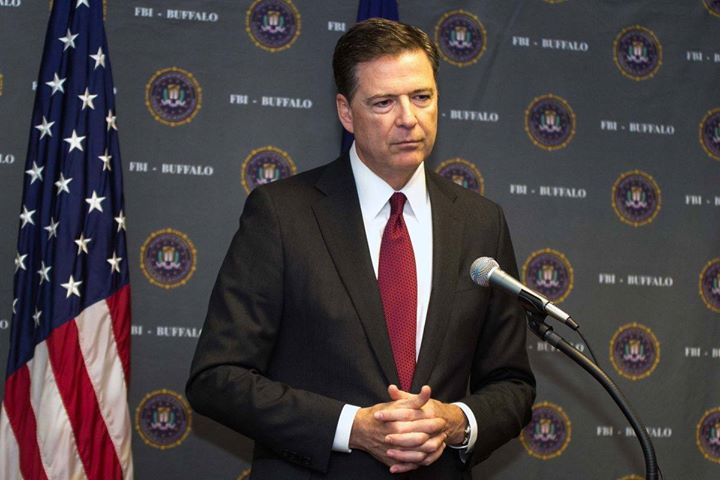
The FBI Director made himself a part of this campaign twice. The first was during the summer when he had the press conference indicating there would be no charges filed in connection with Hillary Clinton’s private e-mail server. This hurt Clinton by an average of about two percentage points. However, the story faded as other stories took precedence and her numbers recovered.
The devastating event was Comey’s revelation that there might be new e-mails found via Anthony Weiner’s connection to Huma Abedin on October 28, 10 days before the election. This was the single most decisive moment of the election. How do we know? Vox has a great primer here. As they did over the summer, Clinton’s numbers dropped two points nationally and more in the states. Her support collapsed from the early vote where she led to the day of voting where she was crushed.
We also this from Brad Fay whose firm Engagement Labs tracks conversations about brands. What he saw was that most conversations about the candidates were negative, which tracks with what we know about their approval ratings. Additionally, Trump was consistently more disliked. However, in the closing days of the campaign, after the Comey letter, that suddenly flipped and Clinton was the more disliked candidate. Given how narrow Trump’s victory was, this suggests to me that the Comey letter flipped the outcome of the election.
VI. Russian Interference and the DNC/Podesta Leaks
This is where things get a little murky for obvious reasons. First let’s establish that almost all analyses of the DNC/Podesta leaks indicate they ultimately originated from Russia. The CIA asserts it is so, as does the most well respected private internet security firm CrowdStrike. To the best of my knowledge, there is no credible counter explanation.
These leaks purportedly indicated that the DNC was actively working on Clinton’s behalf during the Democratic primary. These claims were dramatically overstated by Wikileaks and people who should have known better, but that was the perception they helped create. This belief was most prominent among liberals who supported Sanders in the primary, for obvious reasons. Most of these voters supported Clinton in the general election. There were some, however, who voted third party, and we have less idea of how many stayed home rather than voting. Could this have swung the election by itself? Maybe, but doubtful.
VII. Third Parties
In CBS’s exit poll (unreliable, but indicative), they asked third party voters how they would have voted in a two candidate race. 60% would have stayed home. 25% preferred Clinton, 15% preferred Trump. This would have flipped Michigan by itself, but it would not have been enough in Wisconsin or Pennsylvania. Third parties did not swing the election, however one may feel about them.
VIII. The Media
I’ve already written about the media’s failures in general. The word cloud by itself damns the media’s treatment of this race. What I think is really important is that the DNC leaks and the Comey interference could not have proved decisive without the media’s enabling of them. A proper handling of the e-mail story would have been a few days, deciding the whole server thing was a red herring and moving back to covering issues of importance to Americans, like health care or the economy.
The DNC leaks followed a pattern with Wikileaks: they hype a story and frame it for the press. Because they release on overwhelming number of documents at once, journalists don’t have time to sort through what’s accurate and end up adopting Wikileaks’ position. Such was the case with the DNC hacks where routine political action was frame as nefarious, reinforcing the perception of Clinton was untrustworthy, hurting her campaign. Given that her weakest position was consistently being “honest and trustworthy” this media treatment may have been decisive.
IX. Flawed Democratic Strategy
Note that literally none of the things above were really in the Clinton campaign’s control. Yet they still could have won had they swung 80,000 voters in Wisconsin, Michigan, and Pennsylvania. And a number of Democrats look at Donald Trump and say it’s embarrassing they did not manage to do so. They point to the Clinton campaign’s strategy and indict them for a profound failure. And they’re not wrong.
The Clinton strategy was essentially to try to win a landslide victory to repudiate the politics that won Donald Trump the Republican nomination. There was a lot at the Democratic Convention focused on traditionally Republican images invoking feelings of patriotism and optimism about the future. Michael Bloomberg was given a major speaking position, a number of the major speeches focused on themes of inclusion and bi-partisan consensus about everyone being a part of America. The goal, it seemed, was to peel off moderate Republicans, especially whites with college degrees, who were disgusted by the worst impulses of Donald Trump. The goal, in short, was to kill Trumpism, not just defeat Trump.
A noble goal, and with a candidate who had not been subjected to twenty years of attacks by the Republican Party, poisoning the well for these soft Republicans against her, it might have worked. They had a backup plan, too, which was that the worst case scenario, they would pick up the West Coast, New England, the mid-Atlantic, and the “blue wall” of the Rust Belt: Pennsylvania, Michigan, Wisconsin, and Minnesota, which had all consistently voted for Democrats over the past six presidential elections.
Obviously, both the main strategy and the backup plan failed. The main strategy failed somewhat predictably, as Republicans consistently come home to their candidates. Trump did underperform among college educated whites, but not by enough to swing states like Arizona, North Carolina, or Georgia, where the Clinton campaign invested resources. And Trump dramatically over performed among non-college educated whites, who are more common in the industrial Midwest. Why?
A large part is racism, as explained above. But another factor was messaging. Speaking as a Michigan resident, the main Clinton ad we saw looked like this attacking Trump for being a bad role model for our kids. It didn’t work. Contrast that with the main ad we saw in 2012 from Obama. It used Romney’s “47%” comments to devastating effect. Michigan voters responded to that kind of populism against the rich people they know have screwed them. The other main ad we saw concerned the auto bailout for obvious reasons. This statement from Trump not appearing in every Clinton ad in Michigan and Ohio is political malpractice: “You can go to different parts of the United States and then ultimately you’d do full-circle — you’ll come back to Michigan because those guys are going to want their jobs back even if it is less.”
The Clinton campaign failed to read the mood of the country given Trump’s win and Bernie Sanders’ surprisingly strong showing. The tools were there to attack Trump on a populist basis, but they chose to attack Trump as a racist, sexist, ignoramus. Which was true, but did not fit the mood of the country, and especially the mood of white voters, who still make up a majority.
X. The Future
So what should Democrats learn from the 2016 election? The first and most obvious thing is that people driven campaigns like Obama’s work better than consultant driven campaigns like Clinton’s and the majority of those we have seen lose race after race across the country down ballot. Democrats need their activist base to join the political process and for new volunteers to join that activist base. We are seeing that with things like the Women’s March and voters showing up at town halls across the country.
The second thing is to sell a positive message for people, not necessarily an abstract message about the country. “Stronger Together” is a great sentiment, but what does it mean for me, the individual? What does it mean about my ability to pay for college for my kids, get good health care, have a secure retirement, etc. Even a simple abstract message like “Change We Can Believe In” demonstrates this by saying: not what we have right now.
One lesson we cannot “learn” is that we need to pander to racism, or to soft pedal the real problems faced by minorities in this country because we think it might affect our electoral prospects. There is a moral issue before a political one, and we need to stay on the right side of that. Besides, the Democratic base is partially or even mostly those same minorities and we need to advocate for their issues just as much as every other issue.
Finally, we should remember that this was a close election and Americans historically turn against the party in the White House, because we are a fickle people. Donald Trump, despite his victory, remains deeply unpopular with a majority of Americans, and was not given the benefit of the doubt by people who did not vote for him like most Presidents are. He can be defeated. Starting with his party’s health care bill.

